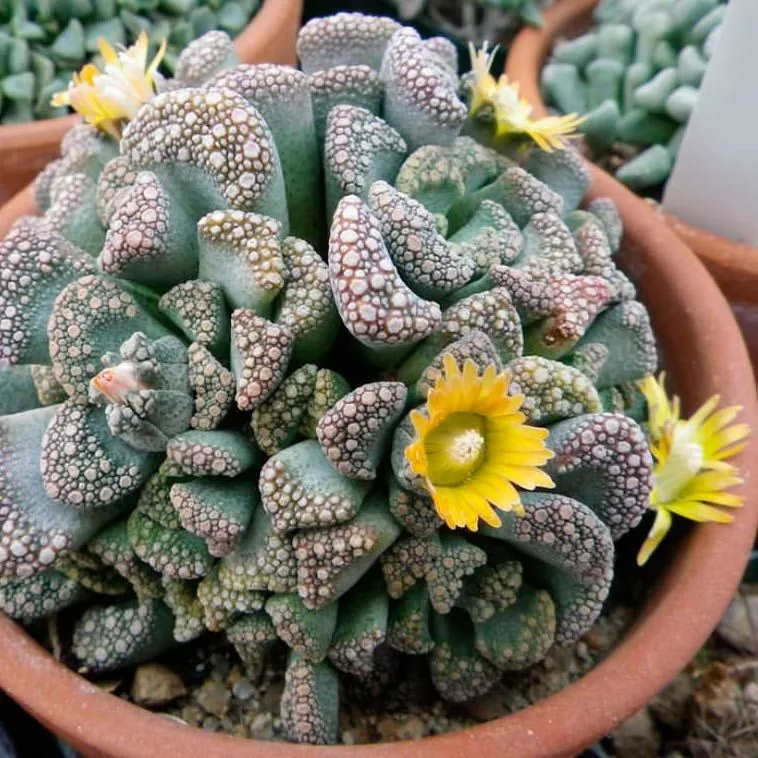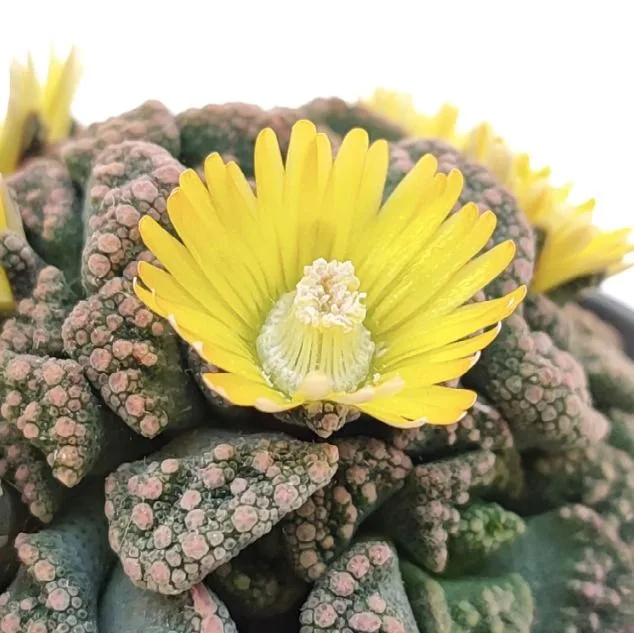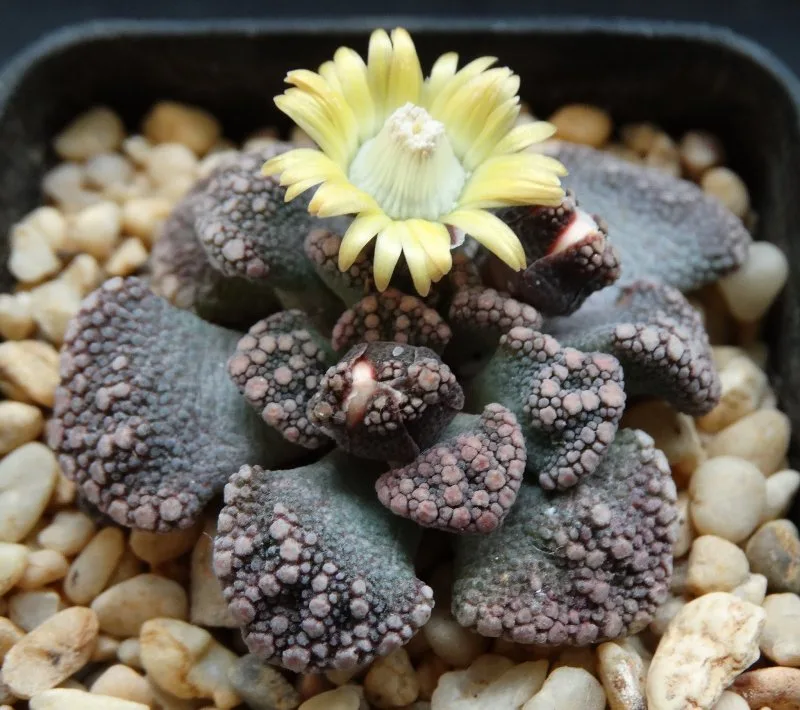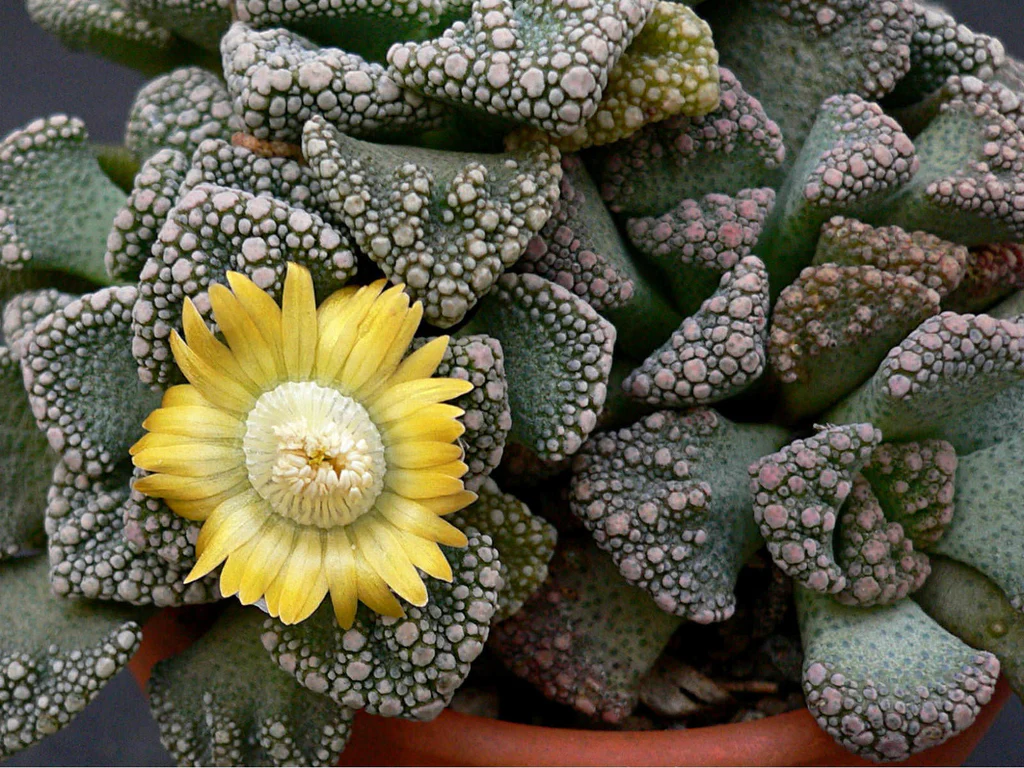index
Apresentação
If you’re looking for a succulent that transcends conventionality, Titanopsis Calcarea, affectionately known as “Concrete Leaf,” is an extraordinary choice. Its robust, fleshy leaves, often covered in a thin layer of white “concrete”, give it a unique and striking appearance. Originally from the arid regions of South Africa, this succulent is adapted to survive in challenging conditions, revealing its resilience and singular beauty.
Meaning of Concrete Leaf Succulent (Titanopsis Calcarea)
The Titanopsis Calcarea not only captivates with its unusual aesthetics, but also carries a symbolic meaning. Its leaves, which resemble sturdy concrete, symbolize strength, resilience and the ability to thrive even in seemingly hostile environments. Growing this succulent in your space is not only an aesthetic experience, but also an inspiring visual reminder of nature’s ability to overcome.
| Common Name | Concrete Leaf Succulent |
|---|---|
| Botanical Name | Titanopsis Calcarea |
| Family | Aizoaceae |
| Type of Plant | Succulent perennial |
| Adult size | 5 to 10 centimeters high |
| Solar Exhibition | Full sun to filtered light |
| Soil Type | Well-drained, sandy soil |
| Soil pH | Slightly acidic to neutral (6.0 to 7.0) |
| Flowering Season | Spring to summer |
| Color of Flowers | Yellow to orange flowers |
| Native Area | South Africa’s arid regions |
| Toxicity | Not known to be toxic to humans |

How to Care for the Concrete Leaf Succulent (Titanopsis Calcarea)
The unique beauty of the Concrete Leaf Succulent (Titanopsis Calcarea) requires specific care to ensure its healthy flowering. Follow this comprehensive guide to provide your succulent with the ideal conditions.
Appropriate Light:
Titanopsis Calcarea thrives in direct to intense sunlight. Make sure you place it in a spot where it receives at least six hours of sunlight every day. Avoid prolonged shade to keep its leaves vibrant.
Well-Drained Soil:
The ideal soil for the Concrete Sheet should be well-drained and aerated. Mix sand and perlite into the soil to ensure good drainage and prevent water from accumulating in the roots.
Moderate Rega:
Avoid overwatering, allowing the soil to dry out completely between waterings. Titanopsis is adapted to arid environments and excessive watering can lead to root rot.
Temperature and Humidity:
This succulent is resistant to warmer temperatures, but protect it from extreme frosts. As for humidity, keep it in a dry environment, as it prefers low humidity levels.
Timely Fertilization:
Fertilize during spring and summer with a balanced fertilizer. Avoid fertilizing during the winter, when the plant enters a period of relative dormancy.
By following these guidelines, you will provide the perfect environment for your Concrete Leaf Succulent to flourish and display its unique beauty.

How to Plant the Concrete Leaf Succulent (Titanopsis Calcarea)
How to Make a Concrete Leaf Succulent Seedling
Propagating the Concrete Leaf Succulent is a rewarding experience. Follow these simple steps to obtain healthy seedlings:
- Choosing the Mother Plant: Select a healthy, mature plant to be the mother plant.
- Leaf removal: Carefully remove healthy leaves from the mother plant. Make sure you remove the leaves whole, without damaging the ends.
- Drying and Callus Formation: Let the leaves dry for a day or two until they form a callus at the cut end.
- Planting the Leaves: Plant the leaves in soil for succulents, burying the calloused end in the ground.
- Moderate Irrigation: Keep the soil slightly moist until the seedlings develop roots.
How to Plant the Concrete Leaf Succulent
When planting the Concrete Leaf Succulent in your garden or pot, follow these guidelines:
- Soil Preparation: Make sure the soil is well drained and mixed with sand for better aeration.
- Suitable spacing: Plant the seedlings at a suitable distance to allow for healthy growth.
- Sun Positioning: Choose a spot with direct sunlight, providing ideal conditions for the succulent.
- Initial watering: After planting, water lightly to establish the seedlings in their new environment.
By following these steps, you will ensure a successful propagation process and the proper planting of the Concrete Leaf Succulent.

Most Common Pests and Diseases:
When growing the Concrete Leaf Succulent, keep an eye out for possible pests and diseases that can affect its health. Below are some of the most common:
- Bugs:
- Symptoms: White or grayish spots on the leaves.
- Solution: Use a solution of water and neutral soap to remove it manually or apply neem oil.
- Mites:
- Symptoms: Fine webs and yellowing of the leaves.
- Solution: Maintain humidity around the plant and use predatory mites.
- Fungi:
- Symptoms: Dark spots on the leaves.
- Solution: Avoid excess water, improve air circulation and apply natural fungicides.
Common Problems and Their Solutions:
Some frequent problems can arise when growing the Concrete Leaf Succulent. Here are solutions to deal with these challenges:
- Root rot:
- Cause: Excess moisture.
- Solution: Reduce watering and replant in better-drained soil.
- Styling:
- Cause: Lack of adequate light.
- Solution: Move the plant to a brighter spot.
- Wilted Leaves:
- Cause: Lack of water.
- Solution: Adjust the watering pattern and supply water when necessary.
By paying attention to these signs and taking proactive measures, you will keep your Concrete Leaf Succulent vibrant and healthy.

Fascinating Curiosities
- Extreme Adaptation: The Concrete Leaf Succulent is known for its ability to withstand adverse conditions such as high temperatures and low humidity.
- Exotic Origin: Originally from the semi-arid regions of South Africa, this succulent thrives in challenging environments.
- Variety of Colors: In addition to the classic green, the leaves of this succulent can display shades of gray, pink and even violet.
Myths Debunked
- Daily Watering: Myth – This succulent prefers moderate watering, avoiding excess moisture which can lead to root rot.
- Slow Growing: Myth – With the right care, the Concrete Leaf Succulent can grow steadily, especially during the growing seasons.
- Poor Soil: Myth – Although hardy, this succulent thrives in well-drained and enriched soil.
Uncover these curiosities and myths to improve your knowledge of the fascinating Concrete Leaf Succulent.
Conclusion
On our journey through the universe of the Concrete Leaf Succulent, we explore everything from its curiosities to debunking some myths. This fascinating plant, which originated in the arid landscapes of South Africa, demonstrates a remarkable capacity for adaptation and resistance.
By knowing the essential care, from sun exposure to moderate watering, you can enjoy a lush and healthy succulent. Remember to keep an eye out for signs of pests and diseases, acting proactively to maintain the beauty and vitality of your Concrete Leaf Succulent. Growing this plant not only adds a touch of exoticism to your space, but also provides an enriching experience of connecting with nature. Invest time and care, and your Concrete Leaf Succulent will reward you with its unique, long-lasting beauty.







